

Being eco-conscious travellers, we face a big dilemma. We go away to marvel at the beauty of nature, but by travelling, we contribute to its destruction. The aim of this article isn’t to give you a moral lesson. We’ll explain the different ways in which travel can affect the environment, but above all, we’ll give you all the solutions to reduce your ecological footprint.
Nowadays, in the scientific community, there’s a near-consensus on the fact that greenhouse gas emissions, particularly carbon dioxide (CO2), are responsible for the gradual increase in the average temperature of the Earth’s surface. If you’re one of the few people who still doubt it, we advise you to read this article.
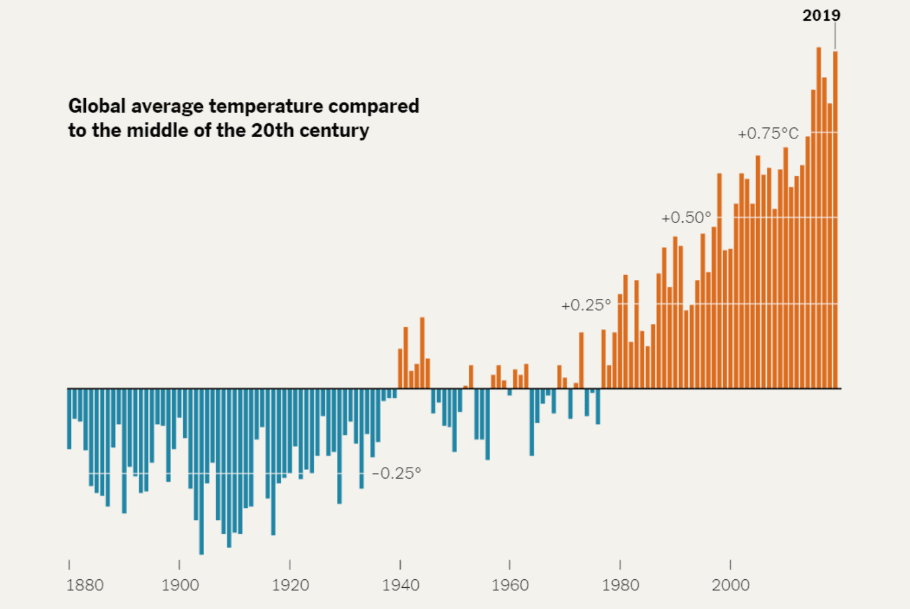

This graph above shows the yearly global surface temperature compared to the average global temperature recorded between 1951 and 1980. Blue bars indicate cooler-than-average years; red bars show warmer-than-average years. For example a bar indicating +0.5 C means that the temperature was at that time 0.5 celsius degrees warmer than the average in the 30-year span from 1951-1980. In 2021 the average global temperature was already more than one degree celsius warmer than in the pre industrial period (1880 – 1990).
Sources : NASA Giss, National Aeronautics and Space Administration Goddard Institute for Space StudiesThe consequences of climate change are already serious and they continue to worsen:
Therefore, climate change has several negative consequences not only on biodiversity, but also directly on humans: drop in crop yields, decrease in water resources, destruction of habitats, expansion of areas infested by certain diseases, abandonment of areas that have become uninhabitable…
It’s difficult to compare the “normal” daily greenhouse gas emissions in your home country with those of a round-the-world (RTW) trip. Indeed, depending on your lifestyle in your home country and your way of travelling, your carbon footprint can vary dramatically. But, we’ll still try to make a comparison. The figures that you see here are averages and shouldn’t be taken at face value. However, they can give you a rough estimate.
CO2 isn’t the only greenhouse gas. Other gases are involved: methane, nitrous oxide… By multiplying their emissions by a conversion factor, we get a figure in “tonnes of CO2 equivalent” (C02e) which represents the global warming potential.
According to the World Bank, in 2018 the average amount of greenhouse gases emitted by Americans is 15.2 tonnes of CO2 equivalent, and 5.4 tonnes of CO2e for Britons. However, if we include gas emitted overseas, used to produce goods and services which are imported by the US and UK, the carbon footprint is 18.1 (US) and 8.8 (UK) tonnes of CO2e per person. (Source: OECD)
According to the United Nations Development Programme, to limit the planet’s warming to +2°C, we need to cut our emissions to 1.7 tonnes of CO2e per person, per year.
According to an article from Environment International (2009), an American’s carbon footprint can be broken down into five categories:
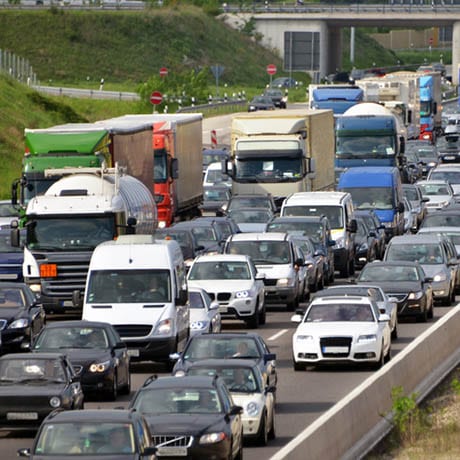

Transport represents more than a quarter of Americans’ CO2 emissions.
We won’t be so smug when Justin Beiber and Harry Styles release summer hits all year round because of global warming…
When travelling, the big difference in CO2 emissions lies in transport. In the US, 28% of the 15.2 tonnes of CO2e corresponds to transport-related emissions of 4.3 tonnes per year and per person on average.
According to our survey, on average round-the-world travellers take 14 flights in economy class, this includes tickets bought along the way. We analysed their itineraries and calculated their emissions. On average, they emit 15 tonnes of CO2e just by taking the plane.
In the US and UK, heating is the main emitter of CO2 in homes. Your carbon footprint linked to housing will therefore be lower when travelling if you mainly go to warm countries, like most round-the-world travellers do. This is because there won’t be any heating (but these savings will be reversed if you systematically use the air conditioning).
When travelling, you’ll eat as much as at home, you might need to be medically treated, you’ll benefit from public services and utilities (water, lighting, rubbish collection, police…) and you’ll need to buy equipment and clothing. Therefore, the last three categories don’t differ that much between a year at home or a year travelling.
1 year in the US according to figures from Environment International:
Total: 18.1 tonnes of CO2 equivalent
1 year on a RTW trip according to our calculations:
Total: 23.4 tonnes of CO2 equivalent
Selon le According to WWF’s Living Planet Report, our planet has lost 60% of its wild vertebrates since 1970. 39% of terrestrial animals, 39% of marine life and 76% of freshwater animals are extinct.
Their data is collected from scientific journals, online databases and government reports. The results reported here are based on 16,704 populations of 4,005 different species.
The major threats to biodiversity are:
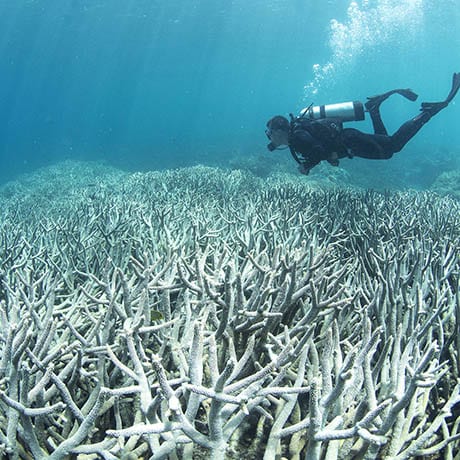

Great Barrier Reef: 30% of coral were affected by bleaching in 2016 and 2017
When we travel, our main impact on biodiversity is through global warming related to transport. For example, by speeding up the warming of water and the acidification of oceans, we’re contributing to coral bleaching. This is harmful as coral reefs are home to 25% of marine life.
But there are several ways in which travellers can have an impact on biodiversity: building hotels which disrupt natural habitats, cutting trees to heat hotels, releasing untreated sewage, throwing plastic bottles which end up in the sea, overfishing to supply restaurants, hikers and divers intruding into natural habitats, introducing invasive species…
According to our calculations, transport represents 68% on average of greenhouse gas emissions during a RTW trip. If you want to reduce the carbon footprint of your trip, then this is where you’ll need to focus most of your efforts. You may be a zero-waste traveller, but if you take several flights your eco-friendly attempts will unfortunately be of little use.
Our first piece of advice is to try and not travel too quickly. When preparing for a RTW trip, you’re like a kid in front of a birthday party buffet. You want to try everything, and you inevitably end up with indigestion. So, try to limit the number of countries you visit. The main advantage of a long trip is being able to leave room for the unexpected. If you travel slowly, you’ll reduce your carbon footprint whilst giving yourself the chance to grab opportunities that are sure to arise along the way.
You don’t have to do a RTW trip either. If you’re travelling for less than a year, perhaps it’s better to focus on one or two continents. This will allow you to really immerse yourself in the local culture and will prevent you from taking highly polluting transcontinental flights.
Comparing CO2 emissions of different means of transport isn’t an easy job, because lots of factors can alter the results:
Numerous calculators allow you to estimate the CO2 emissions of each means of transport. They all give different results. We’ve chosen to exclusively refer to the data from the ADEME database (French Environment and Energy Management Agency). It’s the most complete, because it includes:
Transporting a vehicle (motorhome, campervan…) by a roll-on / roll-off ship emits 419 grams of CO2e per kilometre.
Airplanes are by far the means of transport which have the biggest impact on global warming on a long trip. It represents nearly three quarters of round-the-world travellers’ CO2 emissions.
Airplanes are by far the means of transport which have the biggest impact on global warming on a long trip. It represents nearly three quarters of round-the-world travellers’ CO2 emissions.


Airplanes condensation trails speed up global warming
Airplanes affect the climate in six ways:
Most flight carbon emissions calculators underestimate your real footprint because they only include CO2 emissions.
We therefore advise you to calculate your CO2 emissions yourself by multiplying the number of kilometres of your flights by the corresponding ADEME (French Environment Agency) emission factors.
Airplane emissions in relation to flight distance and number of passengers
(in CO2e grams per passenger and per kilometre)
|
Number of passengers
Distance (km) |
Less than 50 passengers | 50 – 100 passengers | 100 – 180 passengers | 180 – 250 passengers | More than 250 passengers |
|---|---|---|---|---|---|
| Less than 1,000 km | 683 g | 453 g | 314 g | 293 g | |
| 1,000 – 2,000 km | 906 g | 314 g | 258 g | 216 g | |
| 2,000 – 3,000 km | 1,200 g | 209 g | 237 g | 209 g | |
| 3,000 – 4,000 km | 230 g | 230 g | 251 g | ||
| 4,000 – 5,000 km | 293 g | 307 g | 258 g | ||
| 5,000 – 6,000 km | 286 g | 230 g | 223 g | ||
| 6,000 – 7,000 km | 223 g | 209 g | |||
| 7,000 – 8,000 km | 202 g | 209 g | |||
| 8,000 – 9,000 km | 223 g | 230 g | |||
| 9,000 – 10,000 km | 216 g | 223 g | |||
| 10,000 – 11,000 km | 216 g | ||||
| More than 11,000 km | 223 g |
You can find the distance between two cities by typing, for example, “distance London Bangkok” into Google. The type of aircraft you fly in is usually indicated on your ticket. And you can find the number of passengers by type of aircraft on Wikipedia for Airbus and Boeing.
If you don’t want to bother with all of these calculations, you can use this carbon footprint calculator. However, it doesn’t take into account as many criteria, so its results are a little lower than those from the ADEME.
The best way to minimize your impact on the climate is to travel by other means of transport than airplanes.
To do this, you need to have this mindset from the planning stages of your trip. The aim is to try and make your itinerary as continuous as possible, with minimal gaps, to be able to get around on land as much as possible.
If you’re not ready to completely give up on airplanes, you can still limit the number of flights you take. If, instead of taking 14 flights like the average round-the-world traveller does, you manage to limit yourself to one flight between each continent, you’ll already dramatically reduce your CO2 emissions.
For example, if you take a flight from London to Moscow, a flight from Beijing to Los Angeles and a flight from New York to London in economy class, you’ll only emit 2.7 tonnes of CO2, which is six times less than the average RTW trip.
A plane consumes the largest amount of kerosene during landing and take-off. The shorter the flight, the more CO2 it emits per kilometre covered.
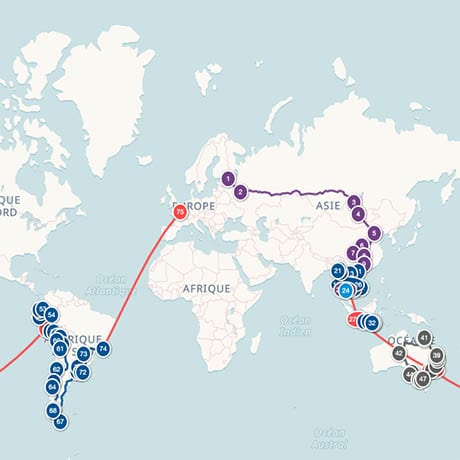

Low-carbon emitting sample itinerary
Therefore, avoid taking flights for short distances and flights with stopovers. Use surface (non-air) sectors as much as possible to limit the distance covered by planes within each continent.
There are three main land routes to get from Europe to Asia:
In travel forums and Facebook groups, we see more and more discussions on the environmental impact of airplanes. Lots of backpackers have negative reactions to people who initiate this type of debate. They put forward several types of arguments to justify the decision to keep taking flights, which often boil down to saying, “Other people pollute more than us, I don’t see why we should make an effort”. We’ve listed them below and have added our viewpoint.
“If you don’t take an airplane, someone else will take your place anyway.”
If you decide to not take a flight for a trip, you lower the global demand. If more and more people decide to fly less, the global demand for flying will decline and this will lower ticket prices. Several flights will therefore no longer be profitable and airlines will close flight routes. CO2 emissions will therefore be reduced.
“Airplanes only represent a small fraction of global CO2 emissions. So travellers don’t really pollute that much.”
According to a 2018 study by Bernd Kärcher published in the Nature Communications journal, taking into account the effect of condensation trails, flying is responsible for 4% of human-made global warming. It’s the fastest growing source of CO2 emissions: +7% per year according to IATA (so it’s doubling every ten years). On a return flight from London to Sydney in economy class, you emit as much CO2 in 48 hours as an average Brit in one year.
“An airplane doesn’t pollute more than a car per kilometre and per person.”
Flying in economy class pollutes almost as much per kilometre as driving a car alone. But by airplane, you cover many more kilometres than by car. Therefore the total amount of CO2 emitted is much higher. So, for a return trip flight from London to Barcelona, you emit as much CO2 as driving 5 km (3.1 mi.) to work each day for a year:
“It’s the Chinese who pollute the most, so what’s the point of making an effort?”
The European Union represents 9% of global CO2 emissions and North America 14% compared to 24% from China. However, you mustn’t forget that there are a lot more Chinese people than us and that a large part of their emissions comes from the manufacture of products that we import. If we attribute the carbon footprint to the final consumer countries, the Chinese emit 6.1 tonnes CO2 equivalent per inhabitant per year, compared to 7.8 tonnes for Europeans and 17.6 tonnes for North Americans (Source: Key Figures on Climate, General Commission for Sustainable Development). A Chinese person therefore pollutes less than a European or North American person.
“It’s mainly manufacturers who pollute, not travellers.”
Industry, including car and airplane manufacturing, is responsible for 21% of global CO2 emissions, in comparison to 14% for transport emissions (Source: US Environmental Protection Agency). If manufacturing pollutes, it’s to make products that we buy. Therefore, it’s up to us to buy less unnecessary items and instead opt for second-hand things more often.
“Having children pollutes more than taking a plane. You don’t have any so you can take a plane.”
A study published in Environmental Research Letters calculated that having one less child equates to a 58 ton reduction of CO2 equivalent for each year that the parents live. This figure was calculated by adding up the child’s emissions and it’s descendants, then dividing this total by the parents life expectancy. Each parent was assigned 50% of the child’s emissions, 25% of the grandchild’s emissions, etc. Indeed, that equates to a nice bunch of airplane trips. But if you’re willing to give up having a child just to reduce your carbon footprint, flying less often is a much easier sacrifice, right?


Private jets are handy for a ski getaway!
“Because the rich are worse than us. You, humble citizen, you don’t have to care about that, you can keep flying.”
In general, the richer you are the more you pollute. You have a bigger house to heat, a bigger car, you take planes more often… But there’ll always be someone richer than us. Globally, almost all western countries inhabitants are rich. If all of earth’s poorest inhabitants suddenly started emitting as much CO2 as Westerners, emissions would explode.
“If you’re careful all year round, you can treat yourself with a flight from time to time.”
If you make the effort all year to get around by bike and on public transport, eat organic and local food, lead a zero-waste lifestyle, eat less meat, buy less and buy second-hand, why would you want to ruin these efforts in the blink of an eye by taking a flight? Not taking a flight is the most effective action you can take to lessen your carbon impact.
“You only have a few weeks holiday per year, flying is the only way to travel quickly.”
For two or three week holidays, why not go to destinations on your continent? If you really want to explore other continents, it’s always possible to go travelling less often, but for a longer period. Of course, that has an impact on your lifestyle. You have to watch your expenses so that you can save up, you might need to postpone a housing project or a car purchase… Ultimately, everything is a matter of priority.
“You’re not like other tourists who take a flight to spend a few weeks on the other side of the world. You’re going away for several months, or even several years.”
Even if you’re under the impression that it’s not as “bad” to take a flight for a long trip than it is for a short holiday, it doesn’t stop the carbon footprint of your flight from being the same. One kilo of CO2 in the atmosphere is still one kilo of CO2 in the atmosphere, no matter how long you spend out there. At the end of the day, what you need to look at is the total amount of flights that you take throughout your life. When you’re travelling for a long period of time, you equally have the time to take other means of transport that isn’t an airplane.
“We’re not going to go back to the Stone Age.”
In the future, advanced technology might allow us to fly without emitting greenhouse gases, or we might even invent ways to capture carbon that will stop us from worrying about our emissions. But, for the moment, we’re far from it and the climate is continuing to heat up. Unfortunately, therefore, we no longer have the time to wait for technology to solve the global warming issue.
After planes, buses are the second most used means of transport amongst round-the-world travellers. Even if a long distance bus uses diesel to run, on average it generates six times less CO2 per passenger than a short-haul flight, and five times less than a car with only one passenger on board.
Therefore, it’s a great means of transport to limit your impact on the climate. You can almost always travel from any point A to any point B in the world by bus, except if there’s a sea or an ocean between the two points.


You’ve got to admit it, it’s a change of scene from a plane.
Most trains in the world are electric. Therefore, they don’t directly emit CO2. However, they indirectly emit it if the electricity they use comes from fossil fuels (coal, gas or oil power plants).
In the US, 60% of electricity comes from fossil fuels (Source: U.S. Energy Information Administration), and in the UK it’s 36% (Source: National Grid ESO). So trains emit CO2, but the figures are lower than other countries like China or India, where over three quarters of electricity comes from fossil fuels.
However, even in countries which produce almost all their electricity from fossil fuels, trains barely pollute more than buses. Diesel trains also hardly emit more CO2 per person than buses.
One of the best ways to reduce a lot of CO2 emissions is to take the Trans-Siberian Railway. This will save you a very long flight between Europe and Asia. Since Russia produces 65% of its electricity from fossil fuels, the train generates around 59 g of CO2e per km and per passenger, so that’s 3.5 times less than a long-haul flight.
If you decide to do a long trip by car, will you pollute less than travelling by airplane?
Most round-the-world travellers who go by car opt for a 4×4. Including indirect emissions, mainly those related to vehicle manufacturing, a Toyota Land Cruiser emits 316 g of CO2e per km. With just one passenger on board, emissions per person are therefore higher than those of an airplane. Once there are two people on board, emissions per person are less than those of an airplane: 158 g of CO2e per km per person compared to 209 g for a long-haul flight.
However, even with four passengers on board, a car still pollutes more than a bus or train.
If you travel by car, picking up hitchhikers on the road is a good way to lower CO2 emissions per passenger.


Vans might look great on Instagram, but they pollute just as much as airplanes.
A campervan like the Volkswagen T4 consumes around 60% more than an average-sized UK car (e.g. a Toyota Corolla). Even with two passengers on board, a van still emits as much CO2 per person as a long-haul flight. Therefore, travelling in a van isn’t that appealing environment-wise, unless you manage to travel with at least three people in it.
Nonetheless, if you sleep in your van, you can save on emissions linked to “permanent” accommodation (which aren’t very high in hot countries).
Lots of travellers rent campervans in New Zealand, Australia, California, Canada or Latin America. If you chose to rent a small car and buy a tent instead, it’ll cost you less and you’ll emit a lot less CO2.
A relatively new motorhome like an Iveco Ducato consumes around two times more than an average UK car. If you’re travelling as a family with two children, this means of transport therefore pollutes less (127 g of CO2e per km and passenger) for a land trip than a long-haul flight (209 g of CO2e per km and passenger).
However, if you do a RTW trip and need to cross an ocean, you also need to take into account the emissions linked to the transport of your motorhome by boat. According to the French Environment Agency, transporting a vehicle by a roll-on/roll-off ship pollutes a lot. It generates 419 g of CO2e per kilometre. Given that passengers can’t board the boat with their vehicle, you’ll also have to buy a plane ticket.
Travelling in a motorhome therefore pollutes less than a plane if you’re travelling with your family and you’re not crossing oceans, or if you buy / rent your vehicle when you arrive in new continents. On the other hand, it pollutes more than a plane if you ship it between continents.
Similar to a van, if you sleep in your motorhome, you’ll save on emissions linked to “permanent” accommodation (which aren’t very high in hot countries).
Round-the-world travellers who go on motorbikes usually opt for powerful engines. Motorbikes over 750 cm3 emit 238 g of CO2e per kilometre on average. That’s more than a long-haul flight. Therefore, from an environmental viewpoint, a motorbike is one of the worst means of transport.
If you travel around by hitchhiking, you’ll use vehicles which emit CO2. However, we think that this means of transport doesn’t contribute to global warming, because no car driver will use their car with the sole aim of picking up a hitchhiker. In this way, your journeys won’t increase the demand for transport. The driver might make a little detour to drop you off at a specific place, but it’s insignificant.
A bike doesn’t emit any CO2. It might be thought that you eat more, so that you have more energy to help you pedal all day long, and that perhaps that produces emissions. But, again, it’s fairly insignificant. However, if you do a RTW trip, you’ll need to find a solution to cross oceans, as a pedalo won’t make the cut.
More and more cities in the world offer self-service bike rental schemes similar to Citi Bike in New York or Santander Cycles in London. It’s a great way to freely explore cities without polluting the environment.
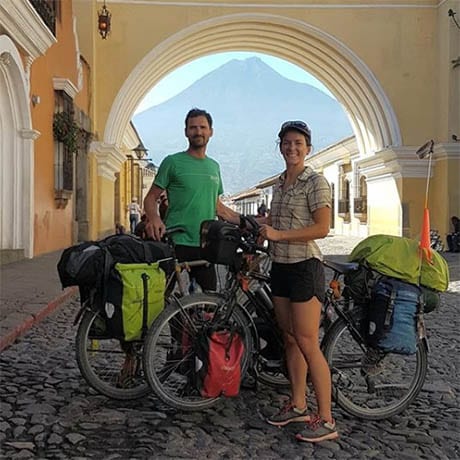

Our friends, Kris and Amelie, in Guatemala
A sailboat is the ultimate zero-emissions means of transport (except on arrival in ports where a small engine is used, but it’s almost insignificant).
You can either buy / rent a boat, or boat hitchhike.
In fact, several sailboat owners look for crewmates to help them during a crossing. You don’t necessarily need to have sailing experience.
You’ll usually only be asked for a small monetary contribution to cover the cost of food, mooring fees and some fuel for entering and leaving ports.
If the boat is big enough, you can also take your bike on board.
You can find boarding offers or post a request on websites like CrewSeekers, FindACrew and CrewBay
On some cargo ships, you can board as a passenger. A cargo ship emits lots of CO2. However, similar to hitchhiking, being on board won’t increase the demand for transport. On a cargo ship, the income generated by passengers is insignificant and it’ll leave whether the passenger cabins are full or not.
We weren’t able to find reliable figures for cruise ship emissions. However, we can assume that they’re at least similar to those of ferries and arguably even superior, because they only carry passengers and therefore have no share of their CO2 emissions allocated to transporting vehicles.
A ferry emits 267 g of CO2e per km, in comparison to 209 g for a long-haul flight.
Therefore, from an environmental point of view of CO2 emissions, ferries and cruise ships are amongst the worst means of transport. What’s more, they give off huge amounts of fine particles in the towns they stop off in.
Here are 5 examples of long-term travel itineraries from blogs. They only apply to trips of at least 9 months and don’t include more than 4 flights.
The equipment you buy before or during your trip has an impact on the environment. The manufacturing of your clothes and your gear emits greenhouse gases, uses a large amount of water and produces harmful chemical substances which are sometimes released into nature. They’re often manufactured in Asia and their transport contributes to global warming. In addition, at the end of their life, they’ll end up as waste, most of which is difficult to recycle. Therefore, they’ll pollute the soil if they’re buried, generate CO2 if they’re incinerated or end up in nature or oceans if they’re not properly treated.


Filtered water bottles save hundreds of plastic water bottles.
When you travel in temperate or cold countries, CO2 emissions related to heating will be the main environmental impact of your accommodation.
When you travel in tropical climates, the accommodation you sleep in won’t need to be heated. On the other hand, it might be air-conditioned. Air conditioning consumes lots of electricity which is predominantly made from fossil fuels in Africa, Latin America and Asia. What’s more, air-conditioners use gases called hydrofluorocarbons (HFCs) which can escape if there is a leak or when the unit is thrown away. HFCs make up a small fraction of greenhouse gases, but they trap a thousand times more heat than CO2.
Building accommodation for travellers also consumes lots of energy (the production of cement / concrete represents 8% of CO2 emissions in the world). Sometimes, it can also disrupt natural habitats.
Finally, untreated wastewater discharged from tourist accommodation is another source of pollution which affects aquatic life in neighbouring rivers and oceans.


Sleeping in a tent is better for the planet
Farming has a huge impact on the climate. According to the EPA, it represents 24% of global greenhouse gas emissions. However, unlike other global warming factors, its footprint is hardly due to CO2 emissions. The three main ways in which farming affects the climate are:
Foods which have the biggest impact on the climate are meat (mainly bovine meat) and dairy products. (83% of the world’s farming land is used for animal husbandry: grazing livestock and crops intended to feed them).
Organic animal waste and pesticides used in crops to feed them also pollute the soil. What’s more, growing food for animals uses much more water than growing plants to eat them directly.
When travelling, you’ll often eat in restaurants. Your meals can therefore also generate lots of waste.


30% of Indians are vegetarians. When in Rome, do as the Romans do.
Tourism puts a huge pressure on natural ecosystems. Travellers can introduce invasive species and diseases, make noise, interact with animals, trample on or pick plants and flowers, leave rubbish behind, make waterways dirty…


Why not go for a hike instead?
A carbon offset is a way to neutralise your carbon emissions racked up by plane rides. It funds projects that aim to reduce the same amount of greenhouse gases elsewhere. These projects are usually located in developing countries.
There are three types of project:
Many organisations allow you to offset your carbon footprint. Some are businesses, others are organisations. We recommend that you go through Good Planet Foundation or Sustainable Travel International.
Projects funded by these organisations:
The cost of a carbon offset for a RTW trip emitting 20 tonnes of CO2 is between $450 (£330) and $600 (£450).
However, offsetting emissions has its limitations. When you emit CO2, that stays in the atmosphere, even if you pay for a Peruvian farmer to reduce your carbon footprint for you. Some people see carbon offsetting as a type of greenwashing. At the end of the day, isn’t it just a way to buy ourselves a clear conscience without having to really change our behaviour?

